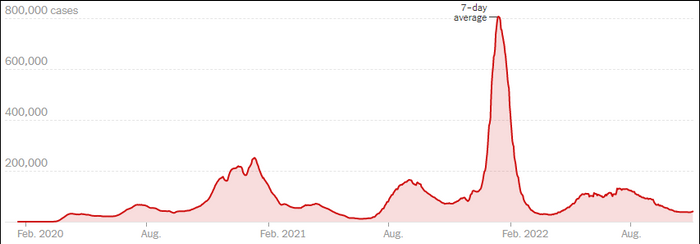First the good news: Pfizer Inc. and Germany-based partner BioNTech SE said updated trial data for their omicron BA.4/BA.5-adapted bivalent booster showed a “substantially higher” immune response in adults than the original COVID-19 vaccine.
The companies said the Phase 2/3 clinical-trial data, collected one month after the boosters were given, also demonstrated that safety and tolerability profiles were similar to those of the original vaccine.
The news sent Pfizer’s stock
PFE,
rallying 1.7% and BioNTech’s U.S.-listed shares
BNTX,
22UA,
surging 7.2% in morning trading.
“As we head into the holiday season, we hope these updated data will encourage people to seek out a COVID-19 bivalent booster as soon as they are eligible in order to maintain high levels of protection against the widely circulating Omicron BA.4 and BA.5 sublineages,” said Pfizer Chief Executive Albert Bourla.
Only 8.4% of eligible Americans have received updated COVID booster shots, while 68.5% of the total population have completed the original primary series of vaccinations, according to the latest data from the Centers for Disease Control and Prevention.
The bivalent booster has been authorized for emergency use in the U.S. by the Food and Drug Administration for people age 5 and older and has also been granted marketing authorization in the European Union for those age 12 and older.
In another piece of good news, Pfizer and BioNTech shares were also lifted by a report in The Wall Street Journal that the Chinese government has agreed to approve the companies’ COVID-19 vaccines for foreign residents in China and has also held talks to approve those vaccines for the broader population.
Meanwhile, Bloomberg reported that China was working on a plan to end the practice of penalizing airlines that bring COVID-infected people into the country.
Both reports boost hopes that China is slowly moving toward ending its zero-COVID policy, which has crimped China’s economy and acted as a drag on global growth.
Now for the bad news.
The seven-day average of new COVID cases topped 40,000 for the first time in a month and hospitalizations have also ticked higher, with more than half of U.S. states showing increases over the past two weeks.
According to a New York Times tracker, the daily average of new cases rose to 40,101 on Thursday from 38,208 on Wednesday, and was up 6% from 14 days ago.

The New York Times
Nevada has seen a 96% jump in daily cases, followed by Tennessee with a 69% increase and Louisiana with a 68% rise, leading the 28 states that saw cases increase over the past two weeks.
Still, daily cases were less than one-third of the summer high of more than 130,000 reached during the surge of the BA.5 variant, the data show.
Coronavirus Update: MarketWatch’s daily roundup has been curating and reporting all the latest developments every weekday since the coronavirus pandemic began
The daily average of COVID-related hospitalizations rose 2% to 27,252, while the number of people with COVID in intensive-care units (ICUs) fell 2% to 3,110.
The daily average of COVID-related deaths fell 6% to a four-month low of 339.
On a global basis, the total number of COVID cases has increased to 631.91 million, while deaths have reached 6,598,197, according to data provided by Johns Hopkins University. The U.S. has seen a total of 97.69 million cases and 1,072,245 deaths.
